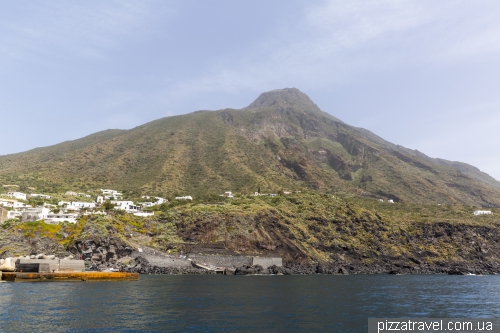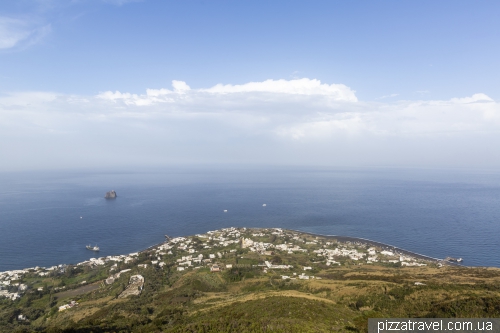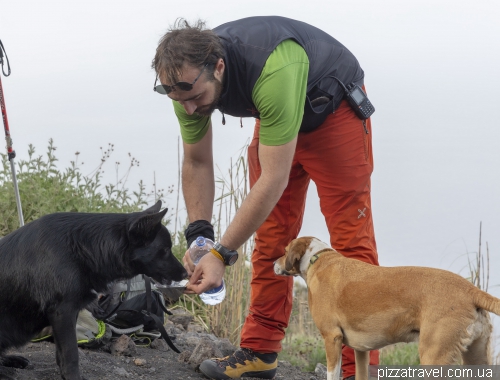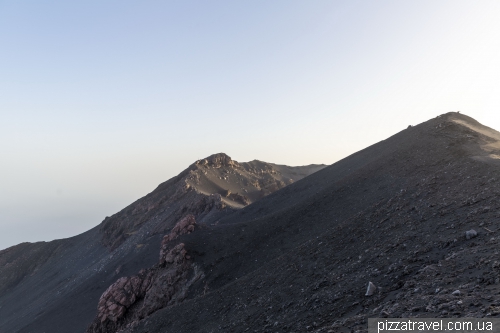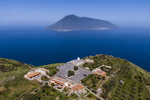It is located on a small island of the same name north of Sicily, which belongs to the group of the Aeolian Islands. Actually, the whole island is a volcano, a small pier and a village for 500 people.
The volcano is active, very active. Small eruptions, which tourists come to see, occur over the past 20 thousand years every 15-20 minutes. But in the summer of 2019, there were two large eruptions.
July 3, 2019. Here tourists captured the moment of the explosion. During this eroption a tourist died at the top. Perhaps you also read in the press that other tourists, jumped into the water to save their lifes.
August 28, 2019. In this video, you can clearly see why a jump into the water doesn't save you.
This same slope during our visit
After these “positive” videos, we’ll show you how to get to the volcano. You can come to the island yourself, or book a tour. Options to get to Stromboli:
From Milazzo
https://www.libertylines.it/en/ - speed boats and ferries
https://carontetourist.it/en/siremar - speed boats and ferries
From Naples
https://www.snav.it/en/ - speed boats in the summer, daily
https://carontetourist.it/en/siremar - night ferries several times a week
From Palermo
https://www.libertylines.it/en/ - speed boats in the summer
From Lipari
https://www.damassimo.it/eng/escursione-stromboli.html - day tour.
Many of the ferries stop on the way at Lipari, use the links above
Attention! In bad weather, ferries do not go. We waited 24 hours in the hotel until the storm ended. Also you will be in the open sea. In our case, the boat was very small (on the picture) and we had see sickness.
Of course you had to leave your car on the parking lot. On the island of Stromboli you have to book a hotel (booking.com) and a guide. Both are obligatory as you will return late from the volcano. The only option, without spending the night, is to do as we do and book a one-day tour from Lipari https://www.damassimo.it/eng/escursione-stromboli.html.
If you are traveling on your own, then book a guide of this company, it is the most famous https://magmatrek.it/en/, on their website you can also see the status of the volcano.
Attention! On the Internet you can find reviews of tourists who went to the volcano alone to save the money, usually early in the morning when there are no people there. Do not do so. Firstly, it’s dumb, because you simply won’t see the eruption in the day light or in the morning fog. And secondly, this is a dangerous place, you can turn the wrong way, a cloud of volcanic ash will cover you, hot gas will burst from under your feet, or stones will fly over your head. Guides go there every day and know where the eruptions occur. Also you can learn a lot of useful information.
What to bring
Do not wear an expensive clothing, volcanic ash may not be removed. The same applies to shoes, no sandals and sneakers. You need special high boots that you can rent on site for 6 euros.
You will also need to rent a flashlight for few euros if you don’t have one. A helmet is given for free. Still need a windbreaker, warm clothes, a spare T-shirt, long pants, sandwiches and plenty of water.
Climb
Climbs start after lunch, and the time depends on the time of sunset. The elevation is quite large - 900 meters. But, given that you will be walking in a group, very slowly and with stops, the climb is simple. For us it was more of a walk.
Several dogs followed us to the very top, the guide gave them water during stops.
We were surprised to learn that he also knows the dog we met on Mount Etna.
On the top
Already on the way to the top, the rumble of explosions will begin to intensify. At some point, the sound will be so loud that you really get scared.
Eruptions here are almost always explosive, without lava. Moreover, each explosion throws burning stones to a height of tens, and even hundreds, meters. In case of a strong eruption, you need to hide in special shelters.
On the top we spent about an hour and a half and saw 4-5 eruptions. The stones did not fly high, everything was pretty safe. You won’t be able to stay longer; it’s really hard to breathe there.
Photographing eruptions is very difficult, as they occur quite quickly. And they are visible only at dusk or in the dark. Better, of course, at dusk, since it is rather difficult to catch focus in the dark. I took this photo after about 50 other attempts.
On the video, it looks like this. The video is not ours, but we saw all the same. There is no loud sound, as it simply cannot be recorded by the camera. I tried to record with the recorder Zoom H1, but also unsuccessfully.
If there is a cloud above, then you may not see anything. Therefore, it is better to prepare for the ascent to the volcano in advance, especially in terms of weather forecast.
Descent
The climb took us 3 hours and the descent only 75 minutes. The fact is that the most difficult part of the path you will go down along a steep slope with volcanic ash.
Legs will be buried in the sand knee-deep and all this in complete darkness. This is where you will use your special shoes, long pants and a flashlight.
Every year we have the most memorable adventure. In 2019 the climb to the Stromboli volcano was definitely the most interesting, we recommend it.
